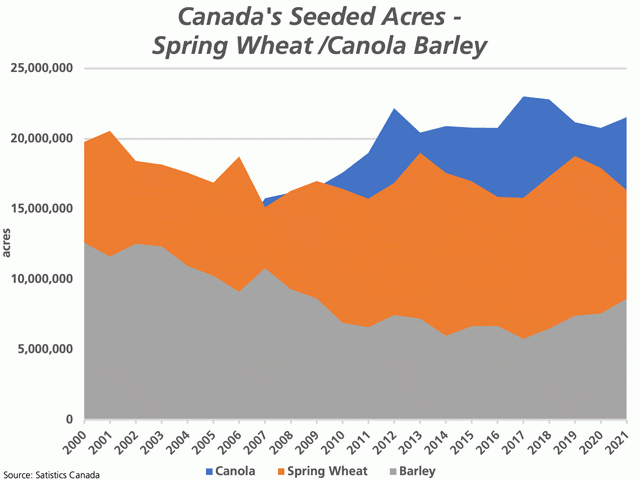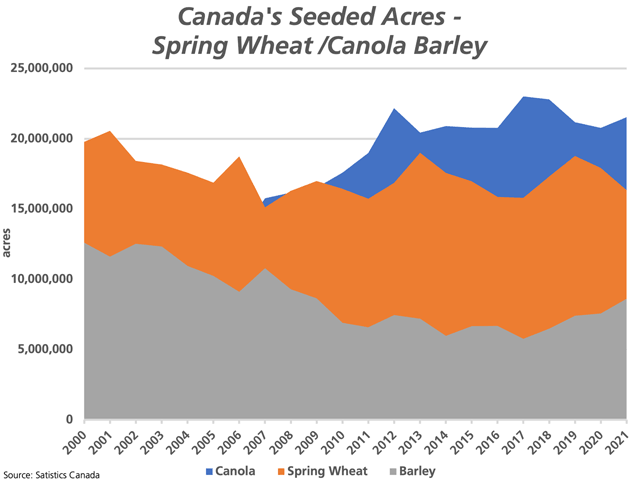Canada Markets
Statistics Canada 2021 Seeded Acre Estimates
Statistics Canada summarized the July 27 Statistics Canada Principal field crop areas based on March producer surveys as showing farmers intend to plant more canola, barley, soybeans, and corn in 2021 while acres of wheat, oats, dry peas, and lentils are expected to decrease. During the current trend of tightening global grain stocks and strong demand for many crops, the outcome of this report will have implications for supplies and prices in the year ahead.
A look at Statistics Canada's forecast for total acres seeded in 2021 for all crops shows a year-over-year drop in total acres seeded, which seems suspicious given the record prices currently seen for some crops. The summary page reported by Statistics Canada shows 371,000 fewer acres planted, while this calculation for the Prairies shows 518,500 fewer acres planted. This bears watching in future reports.
As expected, Canada's all-wheat acres are forecast to fall, with a drop of 6.9% to 23.260 million acres. This would be the lowest wheat acres planted in four years, while 3.7% below the five-year average. This falls within the range of Dow Jones pre-report estimates of 21 to 24.6 million acres.
This includes a 0.3% increase in durum acres to 5.705 million acres, the largest acres seen in three years and 1.6% higher than the five-year average. This area is at the upper-end of the pre-report estimates ranging from 5 to 6 ma, while when inserted into AAFC's supply and demand estimates, would indicate crop year supplies of approximately 6.8 million metric tons while ending stocks would remain below 1 mmt, very similar to the 810,000-metric-ton carryout forecast for the current crop year.
Today's forecast also includes an 8.8% drop in spring wheat acres to 16.340 ma, down for a second year and to the smallest spring wheat acres seeded in four years. This is 4.7% below the five-year average. Saskatchewan producers are forecast to seed 6% fewer acres, Alberta producers are to seed 7% fewer acres and Manitoba producers are to trim acres by 12%.
Today's estimates saw winter-wheat remaining at 1.215 ma, down 11.2% from last year and 8.4% below the five-year average. Combined wheat acres excluding durum total 17.6 ma, which is 900,000 ma below the current unofficial estimates from AAFC that resulted in modest build in stocks for the 2021-22 crop year. This indicates that stocks of wheat in Canada are poised to tighten in the year ahead.
P[L1] D[0x0] M[300x250] OOP[F] ADUNIT[] T[]
The one crop watched closely today was the estimate for canola due to the current tight fundamental situation faced. The Dow Jones pre-report estimates showed the expected increase in seeded acres to range from 21.5 ma all the way to a record 23.2 ma. Bear in mind the producer surveys were conducted in March, when the November contract ended the month at $619.50/mt, while today's high has reached $711.50/mt at the time of writing.
Today's report estimated canola acres at 21.530 ma, at the lower-end of the expected range, the first year-over-year increase seen in four years, up 3.6% from 2020 but down 0.9% from the five-year average. This increase is only marginally lower than the increase in acres seen in the unofficial forecast released by AAFC in April, which estimates 2021-22 stocks unchanged from the current crop year. In the words of one tweet today, this report threw fuel on the fire. At the same time, today's new-crop trade has traded in both positive and negative territory, while the November/January spread has weakened during the past week. Traders perhaps do not believe this report, while attention will quickly turn to dry soils on the Prairies and yield potential.
Barley acres were estimated at 8.613 ma, which would reflect a fourth annual increase in area and the highest acreage seeded in 12 years or since 2009. This is higher than the range of the pre-report estimates reported at 7.7 ma to 8.5 ma, while up 13.9% from 2020 and 27% higher than the five-year average. This area is well-above the 7.9% increase seen in AAFC's unofficial forecast released in April, which resulted in a modest year-over-year increase in stocks for 2021-22. An area such as this would be a relief for the feed industry, although continued competition can be expected from China as barley was named on their list of crops that are targeted as a means of reducing reliance on corn.
Oat acres are to fall by 6% to 3.608 ma, below the lower end of the range of pre-report estimates that looked for 3.7 to 4.2 ma. This still remains 7.8% higher than the five-year average. Such an acreage could lead to stocks remaining close to record-low levels, while at a time when estimates are being released showing oat milk facing "explosive demand" that is to continue to increase by 15% annually through to 2027.
Soybean acres are estimated at 5.348 ma, up 5.5% from 2020 and 10.8% below the five-year average. The report shows acres in Quebec rising by 4.2% to the largest area in three years and Ontario's area up 2% to the largest area in two years. After reaching a high of 2.290 million acres in 2017, Manitoba's seeded areas have fallen each year to a recent low of 1.150 ma in 2020, while are forecast to rise by 17.3% to 1.349 ma in 2021. The first estimates for Saskatchewan and Alberta will be released later in the June estimates.
This forecast area is slightly lower than the 5.7 ma used by AAFC in their unofficial estimates, which forecasts ending stocks of 225,000 mt as of Aug. 31 2021, which would be the lowest since August 2013. Given the move in prices seen over the past month, it is very likely that the area of soybeans and canola will be higher than reported in today's report.
Flax acres are forecast at 982,000 acres, which would be the largest area planted in four years, up 5.5% from 2020 and 4.2% higher than the five-year average. This is not as large of an increase as shown in AAFC's unofficial estimates that allowed for a year-over-year increase in stocks.
Corn acres were estimated to climb by 1.8% to 3.623 ma, while 0.4% higher than the five-year average. Acres in Quebec are to rise by 1.2%, acres in Ontario are forecast to rise by 1.7% to a record 2.229 ma and acres in Manitoba are forecast to rise by 7% to 398,400 acres. This forecast is higher than the 3.459 ma seen in AAFC's unofficial forecast, which will allow exports to increase while keeping ending stocks steady.
Lentil acres are forecast to fall by a modest 0.3% to 4.218 ma, within the range of pre-report estimates from 4 ma to 4.5 ma while 3.1% below the five-year average. Ending stocks are expected to remain tight at the end of 2021-22.
Dry pea acres are forecast to fall by 9.8% to 3.839 ma, the smallest area in three years and 6.7% below the five-year average. This is lower than the 4.324 ma used in AAFC's unofficial forecast, that already points to tightening stocks in the crop year ahead. This forecast is bullish for peas and will lead to supported prices ahead.
Cliff Jamieson can be reached at cliff.jamieson@dtn.com
Follow him on Twitter @Cliff Jamieson
(c) Copyright 2021 DTN, LLC. All rights reserved.






Comments
To comment, please Log In or Join our Community .